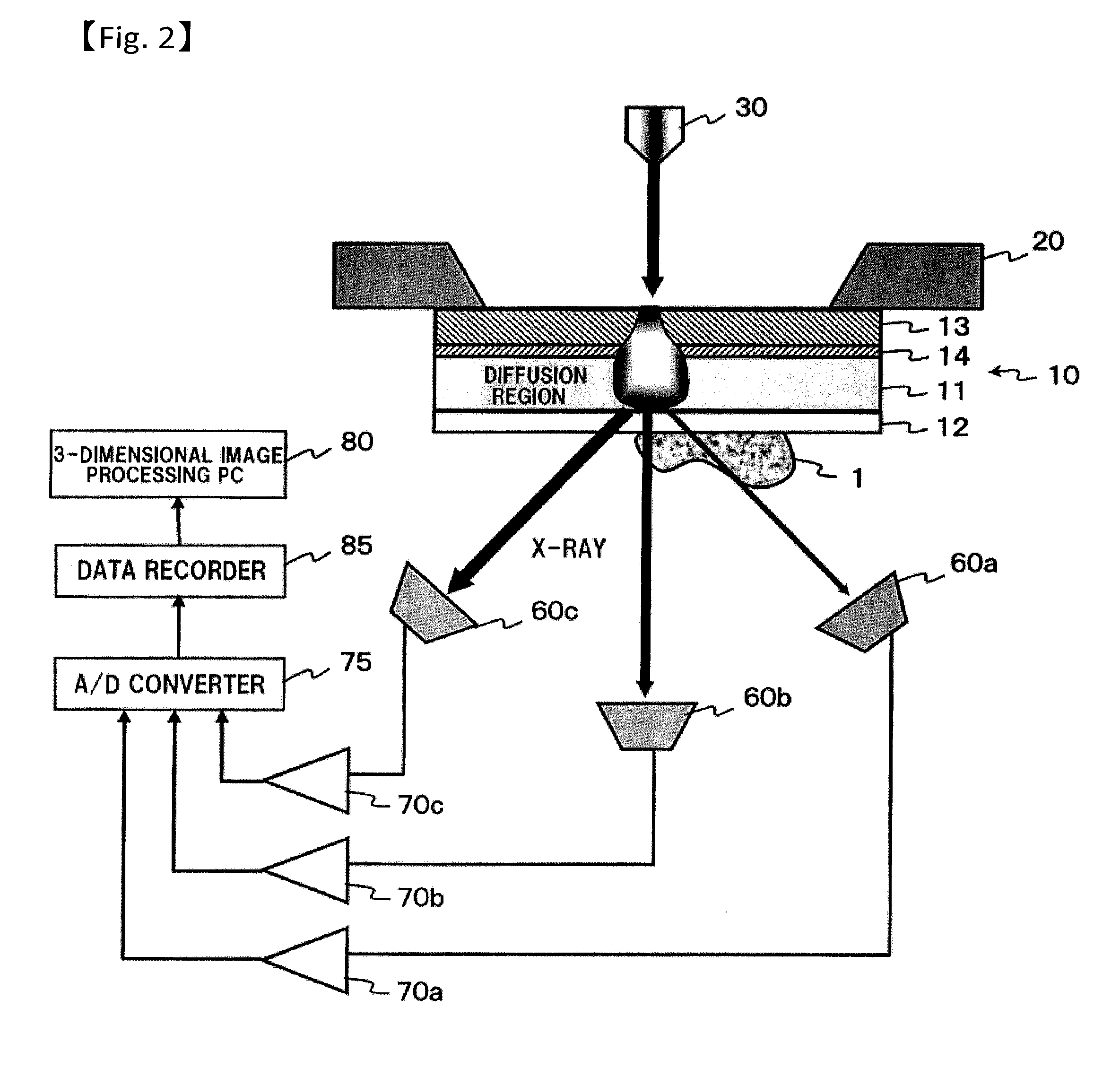Specimen supporting member for x-ray microscope image observation, specimen containing cell for x-ray microscope image observation, and x-ray microscope
a technology of microscope image and supporting member, which is applied in the field of observation technique of x-ray microscope image, can solve the problems of specimen fixing agent itself, lack of durability, and significant reduction of the contrast of the resulting observation image, and achieve the effect of reducing damage to the specimen and convenient high-resolution x-ray observation
- Summary
- Abstract
- Description
- Claims
- Application Information
AI Technical Summary
Benefits of technology
Problems solved by technology
Method used
Image
Examples
example 1
[0130]FIG. 13A is an X-ray image obtained by vapor depositing a nickel film of 120 nm thickness as the specimen adsorption film on a specimen supporting film made up of a silicon nitride film of 50 nm thickness, and fixing and observing yeast with this specimen adsorption film. Further, FIGS. 13B to 13D are respectively a diagram showing the result of a simulation of the case where an electron beam is made to irradiate the above described specimen supporting member; a diagram showing the result of a simulation of the radiant quantity of characteristic X-ray of nitrogen emitted from the specimen supporting film of silicon nitride at the time of electron beam irradiation shown in FIG. 13B; and a diagram showing the result of a simulation of the X-ray transmittance rate of a nickel film of 120 nm thickness.
[0131]The simulation shown in FIG. 13B shows an electron beam scattering state in the specimen supporting film and the specimen adsorption film obtained by a Monte Carlo simulation, ...
example 2
[0133]FIG. 14A is an X-ray image obtained by vapor depositing a nickel film of 60 nm thickness as the specimen adsorption film on the specimen supporting film made up of a carbon film of 40 nm thickness, and making bacteria as an observation specimen absorb to the nickel film and observing it at a magnification of 2000, and it can be confirmed that the bacteria are quite uniformly adsorbed in an appropriate manner.
[0134]FIG. 14B is an image when the above described observation magnification of bacteria is raised to 15,000, at which magnification the internal structure of bacterium is observed in detail.
[0135]FIG. 14C is a diagram showing the result of a simulation of the case where an electron beam is made to irradiate the above described specimen supporting member, in which the simulation determined the scattering state of an electron beam in the specimen supporting film and the specimen adsorption film by the Monte Carlo simulation, where the acceleration voltage of electron beam ...
example 3
[0137]FIG. 15A is a diagram showing a scattering state of electron beam determined by a Monte Carlo simulation when plural kinds of X-ray radiation films are laminated, wherein the lamination is made from the electron beam incidence side in an order from a carbon film (20 nm), an aluminum film (20 nm), and a titanium film (20 nm), and the acceleration voltage of electron beam is 5 kV. Laminating thin films made up of plural kinds of metal allows a plurality of characteristic X-rays to be radiated, enabling the measurement of elementary composition within a specimen from those absorption ratios and the like. Moreover, forming thin film layers by laminating from the electron beam incidence side in an order from a lighter element to a heavier element allows the scattering range of electron beam to be suppressed.
[0138]FIG. 15B is a diagram showing the radiation range (the extent of spreading of characteristic X-ray intensity) of characteristic X-rays from each of a carbon film (20 nm), ...
PUM
 Login to View More
Login to View More Abstract
Description
Claims
Application Information
 Login to View More
Login to View More - Generate Ideas
- Intellectual Property
- Life Sciences
- Materials
- Tech Scout
- Unparalleled Data Quality
- Higher Quality Content
- 60% Fewer Hallucinations
Browse by: Latest US Patents, China's latest patents, Technical Efficacy Thesaurus, Application Domain, Technology Topic, Popular Technical Reports.
© 2025 PatSnap. All rights reserved.Legal|Privacy policy|Modern Slavery Act Transparency Statement|Sitemap|About US| Contact US: help@patsnap.com



